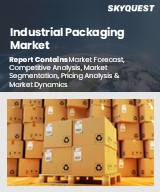
|
시장보고서
상품코드
1801112
유연한 중간 벌크 컨테이너 시장 보고서 : 제품, 최종 이용 산업, 지역별(2025-2033년)Flexible Intermediate Bulk Container Market Report by Product (Type A, Type B, Type C, Type D), End Use Industry (Food, Chemicals, Pharmaceuticals, and Others), and Region 2025-2033 |
||||||
세계 유연한 중간 벌크 컨테이너 시장 규모는 2024년 57억 달러에 달했습니다. 향후 IMARC Group은 2033년에는 85억 달러에 달할 것으로 예상되며, 2025년부터 2033년까지 4.31%의 연평균 성장률(CAGR)을 기록할 것으로 예측했습니다. 산업화의 발전, 효율적인 포장 솔루션에 대한 수요 증가, 화학 및 식품 산업의 급격한 성장, 물류 및 운송 부문의 제품 사용 확대 등이 시장 성장을 강화하는 주요 요인으로 작용하고 있습니다.
유연한 중간 벌크 컨테이너(FIBC) 시장 동향:
산업화의 진전
화학, 농업, 건설, 제약 등의 산업은 빠르게 성장하고 있으며, 이는 대량 포장 솔루션에 대한 수요 증가로 이어지고 있습니다. 대량의 재료를 효율적으로 처리할 수 있는 것으로 알려진 FIBC는 이러한 분야에서 점점 더 선호되고 있습니다. 큰 과립에서 미세한 분말에 이르기까지 다양한 제품 운송에 적응하는 FIBC는 이러한 분야에서 필수적인 구성요소로 자리 잡았습니다. 또한, 아시아태평양과 라틴아메리카를 중심으로 한 신흥 경제권에서 진행 중인 산업 확장은 FIBC의 수요를 더욱 증가시키고 있습니다. 이들 지역에서는 제조업이 호황을 누리고 있으며, 이에 따라 신뢰할 수 있고 비용 효율적인 벌크 포장 솔루션에 대한 수요가 증가하여 유연한 중간 벌크 컨테이너 시장의 성장을 뒷받침하고 있습니다.
효율적인 포장 솔루션에 대한 수요 증가
보다 효율적이고 지속가능한 포장 솔루션에 대한 요구가 증가하면서 또 다른 중요한 성장 촉진요인으로 작용하고 있습니다. FIBC는 경질 용기나 소형 봉지 등 기존 포장 방식에 비해 큰 이점을 제공합니다. 상품 보호에 탁월하고, 포장 폐기물을 줄이고, 보관 및 운송 효율을 최적화합니다. 이러한 효율성은 대량 취급 및 운송이 필수적인 산업에서 특히 중요합니다. 또한, FIBC는 가볍고 접을 수 있으며 재사용이 가능하기 때문에 환경에 미치는 영향을 최소화하고 운송비용을 절감할 수 있습니다. 또한, 첨단 재료의 사용과 안전 기능 강화 등 FIBC 설계 및 제조의 끊임없는 발전은 FIBC의 채택을 더욱 촉진하고 있습니다. 이러한 기술 혁신은 엄격한 안전 및 규제 표준을 준수하며, 신뢰할 수 있고 효율적인 포장 솔루션을 원하는 다양한 산업 분야에서 유연한 중간 벌크 컨테이너에 대한 수요를 강화하고 있습니다.
물류 및 운송 분야 확대
공급망의 복잡성과 효율적인 자재 취급 솔루션의 필요성으로 인해 FIBC에 대한 수요가 증가하고 있습니다. 이 컨테이너는 대량의 상품을 안전하고 효율적으로 운송하는 데 이상적입니다. 까다로운 취급 및 환경 조건을 견딜 수 있도록 설계되어 제품의 안전한 배송을 보장합니다. E-Commerce의 부상과 무역의 세계화는 효과적인 대량 포장 솔루션의 필요성을 더욱 높이고 있습니다. FIBC는 현대 물류 업무의 요구 사항을 충족하는 데 필요한 유연성과 내구성을 제공합니다. 이와 더불어 물류 및 창고 관리의 자동화 추세도 FIBC의 도입 확대에 기여하고 있습니다. 자동 핸들링 시스템과의 호환성은 업무 효율성을 높이고 인건비를 절감하여 물류 및 운송 회사에게 매력적인 선택이 되고 있습니다.
목차
제1장 서문
제2장 조사 범위와 조사 방법
- 조사 목적
- 이해관계자
- 데이터 소스
- 1차 정보
- 2차 정보
- 시장 추정
- 상향식 접근
- 하향식 접근
- 조사 방법
제3장 주요 요약
제4장 소개
제5장 세계의 유연한 중간 벌크 컨테이너 시장
- 시장 개요
- 시장 실적
- COVID-19의 영향
- 시장 예측
제6장 시장 내역 : 제품별
- 유형 A
- 유형 B
- 유형 C
- 유형 D
제7장 시장 내역 : 최종 이용 산업별
- 식품
- 화학제품
- 의약품
- 기타
제8장 시장 내역 : 지역별
- 북미
- 미국
- 캐나다
- 아시아태평양
- 중국
- 일본
- 인도
- 한국
- 호주
- 인도네시아
- 기타
- 유럽
- 독일
- 프랑스
- 영국
- 이탈리아
- 스페인
- 러시아
- 기타
- 라틴아메리카
- 브라질
- 멕시코
- 기타
- 중동 및 아프리카
제9장 SWOT 분석
제10장 밸류체인 분석
제11장 Porter's Five Forces 분석
제12장 가격 분석
제13장 경쟁 구도
- 시장 구조
- 주요 기업
- 주요 기업 개요
- Bag Corp.
- Berry Global Inc.
- Bulk Lift International LLC
- Global-Pak Inc.
- Greif Inc.
- Isbir Sentetik Dokuma Sanayi A.S.
- Langston Companies Inc.
- LC Packaging International BV
- Plastipak Group
- Rishi FIBC Solutions Pvt. Ltd.
The global flexible intermediate bulk container market size reached USD 5.7 Billion in 2024. Looking forward, IMARC Group expects the market to reach USD 8.5 Billion by 2033, exhibiting a growth rate (CAGR) of 4.31% during 2025-2033. The increasing industrialization, growing demand for efficient packaging solutions, the burgeoning growth of the chemical and food industries, and widespread product utilization across the logistics and transportation sectors are some of the key factors strengthening the market growth.
Flexible Intermediate Bulk Container Market Trends:
Increased industrialization
Industries such as chemicals, agriculture, construction, and pharmaceuticals are experiencing rapid growth, leading to a higher demand for bulk packaging solutions. FIBCs, known for their ability to handle large quantities of materials efficiently, are increasingly favored in these sectors. Their adaptability in transporting a broad variety of products, from large granules to fine powders makes them an essential component in these sectors. Moreover, the ongoing industrial expansion in emerging economies, particularly in Asia-Pacific and Latin America, is further propelling the demand for FIBCs. These regions are seeing a boom in manufacturing activities, which, in turn, is boosting the need for reliable and cost-effective bulk packaging solutions, thus supporting the flexible intermediate bulk container market growth.
Rise in demand for efficient packaging solutions
The growing need for more efficient and sustainable packaging solutions is acting as another significant growth-inducing factor. FIBCs offer significant advantages over traditional packaging methods, such as rigid containers and smaller sacks. They provide superior protection for goods, reduce packaging waste, and optimize storage and transportation efficiency. This efficiency is particularly crucial in industries where bulk handling and transportation are vital. Moreover, FIBCs minimize environmental impact and contribute to lower transportation costs because they are lightweight, collapsible, and reusable. Additionally, continuous advancements in FIBC design and manufacturing, such as the use of advanced materials and enhanced safety features, are further driving their adoption. These innovations comply with stringent safety and regulatory standards, thus bolstering the flexible intermediate bulk container demand in various industries seeking reliable and efficient packaging solutions.
Expansion of the logistics and transportation sectors
The increasing complexity of supply chains and the need for efficient material handling solutions have led to a higher demand for FIBCs. These containers are ideal for transporting large volumes of goods safely and efficiently. They are designed to withstand rigorous handling and environmental conditions, ensuring the safe delivery of products. The rise of e-commerce and the globalization of trade have further amplified the need for effective bulk packaging solutions. FIBCs offer the flexibility and durability required to meet the demands of modern logistics operations. Besides this, the trend towards automation in logistics and warehousing has also contributed to the growing adoption of FIBCs. Their compatibility with automated handling systems enhances operational efficiency and reduces labor costs, making them an attractive option for logistics and transportation companies.
Flexible Intermediate Bulk Container Market Segmentation:
Breakup by Product:
- Type A
- Type B
- Type C
- Type D
Type A accounts for the majority of the market share
Based on the flexible intermediate bulk container market research report, type A dominates the market due to its widespread use in various non-flammable applications. These standard, non-conductive FIBCs are cost-effective and suitable for transporting and storing dry, non-hazardous materials such as grains, seeds, and powders. Their simplicity in design and lower manufacturing costs compared to more specialized FIBCs, like Type B, C, and D, make them highly attractive to industries with basic bulk packaging needs. Their popularity is further enhanced by their versatility and efficiency in handling large volumes of materials. In addition to this, the extensive availability and ease of production of type A product variants are boosting the flexible intermediate bulk container market revenue.
Breakup by End Use Industry:
- Food
- Chemicals
- Pharmaceuticals
- Others
Food holds the largest share of the industry
The increasing demand from the food industry, where these products are used for efficient and hygienic bulk packaging solutions is impelling the flexible intermediate bulk container market value. FIBCs are ideal for transporting and storing large quantities of food products such as grains, flour, sugar, and spices, providing excellent protection against contamination and moisture. Their cost-effectiveness, reusability, and ability to preserve product quality make them a preferred choice in the food sector. Furthermore, stringent food safety regulations are also driving the adoption of high-quality, food-grade FIBCs that meet these standards. Besides this, the increasing global population and rising food trade are presenting lucrative opportunities for market expansion.
Breakup by Region:
- North America
- United States
- Canada
- Asia Pacific
- China
- Japan
- India
- South Korea
- Australia
- Indonesia
- Others
- Europe
- Germany
- France
- United Kingdom
- Italy
- Spain
- Russia
- Others
- Latin America
- Brazil
- Mexico
- Others
- Middle East and Africa
North America leads the market, accounting for the largest flexible intermediate bulk container market share
The report has also provided a comprehensive analysis of all the major regional markets, which include North America (the United States and Canada); Asia Pacific (China, Japan, India, South Korea, Australia, Indonesia, and others); Europe (Germany, France, the United Kingdom, Italy, Spain, Russia, and others); Latin America (Brazil, Mexico, and others); and the Middle East and Africa. According to the report, North America represents the largest regional market for flexible intermediate bulk containers.
The flexible intermediate bulk container market forecast reveals North America as the leading region due to its robust industrial base, particularly in the chemical, food, and pharmaceutical sectors. Concurrent with this, advanced manufacturing technologies and stringent regulatory standards in the region leading to the introduction of high-quality FIBCs are further strengthening the market growth. Additionally, the presence of key market players and extensive distribution networks combined with a strong logistics and transportation infrastructure in North America is increasing the reliance on FIBCs for bulk material handling. Moreover, rising environmental awareness and the shift towards sustainable packaging solutions spurring the demand for reusable and durable FIBCs are positively impacting the flexible intermediate bulk container market outlook.
Competitive Landscape:
- The market research report has also provided a comprehensive analysis of the competitive landscape in the market. Detailed profiles of all major companies have also been provided. Some of the major market players in the flexible intermediate bulk container industry include Bag Corp., Berry Global Inc., Bulk Lift International LLC, Global-Pak Inc., Greif Inc., Isbir Sentetik Dokuma Sanayi A.S., Langston Companies Inc., LC Packaging International BV, Plastipak Group, Rishi FIBC Solutions PVT. Ltd., etc.
(Please note that this is only a partial list of the key players, and the complete list is provided in the report.)
- The competitive landscape is characterized by a mix of established global players and emerging regional companies, driving innovation and competition. Flexible intermediate bulk container companies invest heavily in research and development (R&D) to enhance product features, such as strength, durability, and safety, to meet the evolving demands of various industries. Furthermore, strategic collaborations, mergers, and acquisitions are common as companies seek to expand their market presence and capabilities. Emerging regional players, particularly in Asia-Pacific and Latin America, are also gaining value by offering cost-competitive solutions and tapping into local markets. This competitive environment fosters continuous innovation, driving the overall growth and advancement of the FIBC market.
Key Questions Answered in This Report
- 1.What was the size of the global flexible intermediate bulk container market in 2024?
- 2.What is the expected growth rate of the global flexible intermediate bulk container market during 2025-2033?
- 3.What has been the impact of COVID-19 on the global flexible intermediate bulk container market?
- 4.What are the key factors driving the global flexible intermediate bulk container market?
- 5.What is the breakup of the global flexible intermediate bulk container market based on the product?
- 6.What is the breakup of the global flexible intermediate bulk container market based on the end use industry?
- 7.What are the key regions in the global flexible intermediate bulk container market?
- 8.Who are the key players/companies in the global flexible intermediate bulk container market?
Table of Contents
1 Preface
2 Scope and Methodology
- 2.1 Objectives of the Study
- 2.2 Stakeholders
- 2.3 Data Sources
- 2.3.1 Primary Sources
- 2.3.2 Secondary Sources
- 2.4 Market Estimation
- 2.4.1 Bottom-Up Approach
- 2.4.2 Top-Down Approach
- 2.5 Forecasting Methodology
3 Executive Summary
4 Introduction
- 4.1 Overview
- 4.2 Key Industry Trends
5 Global Flexible Intermediate Bulk Container Market
- 5.1 Market Overview
- 5.2 Market Performance
- 5.3 Impact of COVID-19
- 5.4 Market Forecast
6 Market Breakup by Product
- 6.1 Type A
- 6.1.1 Market Trends
- 6.1.2 Market Forecast
- 6.2 Type B
- 6.2.1 Market Trends
- 6.2.2 Market Forecast
- 6.3 Type C
- 6.3.1 Market Trends
- 6.3.2 Market Forecast
- 6.4 Type D
- 6.4.1 Market Trends
- 6.4.2 Market Forecast
7 Market Breakup by End Use Industry
- 7.1 Food
- 7.1.1 Market Trends
- 7.1.2 Market Forecast
- 7.2 Chemicals
- 7.2.1 Market Trends
- 7.2.2 Market Forecast
- 7.3 Pharmaceuticals
- 7.3.1 Market Trends
- 7.3.2 Market Forecast
- 7.4 Others
- 7.4.1 Market Trends
- 7.4.2 Market Forecast
8 Market Breakup by Region
- 8.1 North America
- 8.1.1 United States
- 8.1.1.1 Market Trends
- 8.1.1.2 Market Forecast
- 8.1.2 Canada
- 8.1.2.1 Market Trends
- 8.1.2.2 Market Forecast
- 8.1.1 United States
- 8.2 Asia Pacific
- 8.2.1 China
- 8.2.1.1 Market Trends
- 8.2.1.2 Market Forecast
- 8.2.2 Japan
- 8.2.2.1 Market Trends
- 8.2.2.2 Market Forecast
- 8.2.3 India
- 8.2.3.1 Market Trends
- 8.2.3.2 Market Forecast
- 8.2.4 South Korea
- 8.2.4.1 Market Trends
- 8.2.4.2 Market Forecast
- 8.2.5 Australia
- 8.2.5.1 Market Trends
- 8.2.5.2 Market Forecast
- 8.2.6 Indonesia
- 8.2.6.1 Market Trends
- 8.2.6.2 Market Forecast
- 8.2.7 Others
- 8.2.7.1 Market Trends
- 8.2.7.2 Market Forecast
- 8.2.1 China
- 8.3 Europe
- 8.3.1 Germany
- 8.3.1.1 Market Trends
- 8.3.1.2 Market Forecast
- 8.3.2 France
- 8.3.2.1 Market Trends
- 8.3.2.2 Market Forecast
- 8.3.3 United Kingdom
- 8.3.3.1 Market Trends
- 8.3.3.2 Market Forecast
- 8.3.4 Italy
- 8.3.4.1 Market Trends
- 8.3.4.2 Market Forecast
- 8.3.5 Spain
- 8.3.5.1 Market Trends
- 8.3.5.2 Market Forecast
- 8.3.6 Russia
- 8.3.6.1 Market Trends
- 8.3.6.2 Market Forecast
- 8.3.7 Others
- 8.3.7.1 Market Trends
- 8.3.7.2 Market Forecast
- 8.3.1 Germany
- 8.4 Latin America
- 8.4.1 Brazil
- 8.4.1.1 Market Trends
- 8.4.1.2 Market Forecast
- 8.4.2 Mexico
- 8.4.2.1 Market Trends
- 8.4.2.2 Market Forecast
- 8.4.3 Others
- 8.4.3.1 Market Trends
- 8.4.3.2 Market Forecast
- 8.4.1 Brazil
- 8.5 Middle East and Africa
- 8.5.1 Market Trends
- 8.5.2 Market Breakup by Country
- 8.5.3 Market Forecast
9 SWOT Analysis
- 9.1 Overview
- 9.2 Strengths
- 9.3 Weaknesses
- 9.4 Opportunities
- 9.5 Threats
10 Value Chain Analysis
11 Porters Five Forces Analysis
- 11.1 Overview
- 11.2 Bargaining Power of Buyers
- 11.3 Bargaining Power of Suppliers
- 11.4 Degree of Competition
- 11.5 Threat of New Entrants
- 11.6 Threat of Substitutes
12 Price Analysis
13 Competitive Landscape
- 13.1 Market Structure
- 13.2 Key Players
- 13.3 Profiles of Key Players
- 13.3.1 Bag Corp.
- 13.3.1.1 Company Overview
- 13.3.1.2 Product Portfolio
- 13.3.2 Berry Global Inc.
- 13.3.2.1 Company Overview
- 13.3.2.2 Product Portfolio
- 13.3.3 Bulk Lift International LLC
- 13.3.3.1 Company Overview
- 13.3.3.2 Product Portfolio
- 13.3.4 Global-Pak Inc.
- 13.3.4.1 Company Overview
- 13.3.4.2 Product Portfolio
- 13.3.5 Greif Inc.
- 13.3.5.1 Company Overview
- 13.3.5.2 Product Portfolio
- 13.3.5.3 Financials
- 13.3.5.4 SWOT Analysis
- 13.3.6 Isbir Sentetik Dokuma Sanayi A.S.
- 13.3.6.1 Company Overview
- 13.3.6.2 Product Portfolio
- 13.3.7 Langston Companies Inc.
- 13.3.7.1 Company Overview
- 13.3.7.2 Product Portfolio
- 13.3.8 LC Packaging International BV
- 13.3.8.1 Company Overview
- 13.3.8.2 Product Portfolio
- 13.3.8.3 Financials
- 13.3.9 Plastipak Group
- 13.3.9.1 Company Overview
- 13.3.9.2 Product Portfolio
- 13.3.10 Rishi FIBC Solutions Pvt. Ltd.
- 13.3.10.1 Company Overview
- 13.3.10.2 Product Portfolio
- 13.3.1 Bag Corp.



















